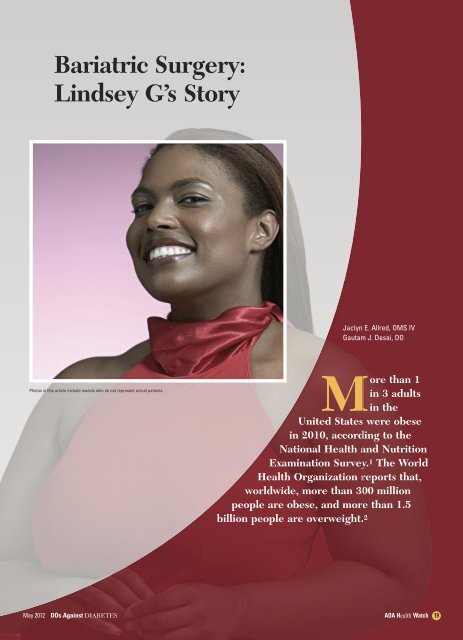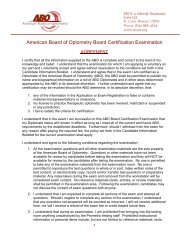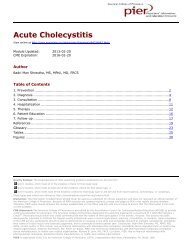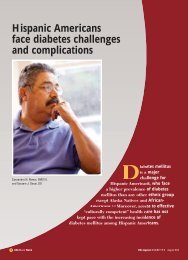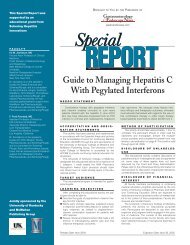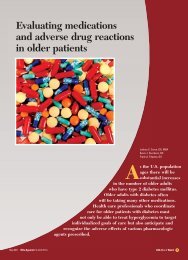Bariatric Surgery: Lindsey G's Story - CECity
Bariatric Surgery: Lindsey G's Story - CECity
Bariatric Surgery: Lindsey G's Story - CECity
Create successful ePaper yourself
Turn your PDF publications into a flip-book with our unique Google optimized e-Paper software.
<strong>Bariatric</strong> <strong>Surgery</strong>:<strong>Lindsey</strong> G’s <strong>Story</strong>Jaclyn E. Allred, OMS IVGautam J. Desai, DOPhotos in this article include models who do not represent actual patients.More than 1in 3 adultsin theUnited States were obesein 2010, according to theNational Health and NutritionExamination Survey. 1 The WorldHealth Organization reports that,worldwide, more than 300 millionpeople are obese, and more than 1.5billion people are overweight. 2May 2012DOs Against DIABETESAOA Health Watch19
The epidemic of obesity, defined as abody mass index (BMI) of more than 30,is worsening. Since 1980, the prevalence ofobesity has doubled throughout the world. 2The US Surgeon General has estimateda 50% to 100% increased risk of early deathfor obese individuals compared to patientswith a BMI between 20 and 25, with morethan 300,000 deaths yearly associated withobesity. 3 A gain of 11 to 18 pounds willdouble an individual’s risk of type 2diabetes mellitus (T2DM) compared to anindividual without that weight gain. 3 Thisrisk is quadrupled if a person has gained 44or more pounds. Sleep quality, mood, andoverall quality of life are also adverselyinfluenced by obesity. 3The reasons for these obesity trends aremultifactorial. For example, there is awidespread prevalence of high-caloriefoods, which are often much cheaper thanhealthier options. In another example,many restaurants have increased theirportion sizes throughout the years. Also—as has always been the case—many peoplemay eat more than they normally would tocelebrate good news, as well as to cope withbad news and stressors in everyday life.The mass media often focuses onunhealthy, though stylish, body images,which may cause unrealistic expectationsfor patients’ self-images. Most people in theUnited States have at some time followed adiet in an effort to lose weight. The weightlossindustry is a multibillion dollarbusiness. Many people find initial successwith diets, but many also regain the weightthat has been lost, and the vast majority ofdieting individuals are unable to maintain ahealthy weight. 4 Medications have not beenIn the United States, morethan 300,000 deaths yearly areassociated with obesity.proven successful in the long-term treat -ment of obese patients. In fact, medicationsmay have undesired, potentially harmfuleffects in many patients.Advances in the surgical treatment ofobese patients have made surgical optionssafer and more widely available. However,many factors must be considered beforereferring a patient for a surgical procedure.In the present article, we do not intend tosuggest surgery as a solution for alloverweight patients, but rather we wish toreveal an actual patient’s point of view andattitudes toward weight loss and surgery.<strong>Lindsey</strong>’s obesity and diabetesmellitusA systematic review of the literaturedemonstrates that bariatric surgery can beefficacious in the treatment of patients withobesity and some of obesity’s comorbidi -ties. 5 A patient of 1 of the authors (G.J.D.)underwent this procedure and was willingto share her story. Her real name willremain confidential, but we will refer to heras “<strong>Lindsey</strong> G.” Her story reveals thechallenges and thought processes that shewent through before electing a surgicaltreatment for her obesity—the laparoscopicadjustable gastric band (LAGB) procedure.The US Food and Drug Administration(FDA) approves LAGB for weight loss inobese adults with a BMI between 30 and40, provided the adults have at least 1obesity-related medical condition and havenot achieved success with nonsurgicalweight-loss methods (ie, lifestyle andbehavior modification). The FDA alsoapproves LAGB for patients with a BMIgreater than 40 and patients who are 100 ormore pounds overweight. 6<strong>Lindsey</strong> was diagnosed as having T2DMin autumn 2009, at age 37 years. At thattime, she weighed 479 pounds and was 69inches (5 feet, 9 inches) tall. She took the20 AOA Health Watch DOs Against DIABETES May 2012
Table. Prescription Medication RegimenMedication—albuterol sulfate—allopurinol sodium 300 mg—alprazolam 0.5 mg—citalopram hydrobromide—cyclobenzaprine hydrochloride—glyburide—insulin glargine—insulin lispro—lisinopril—metoprolol tartrate—oxycodone hydrochloride—pregabalin—simvastatinDosage/Administrationas necessaryorally once dailyorally twice daily as necessary20 mg orally once daily10 mg orally 3 times daily as necessary5 mg orally once daily40 U subcutaneously once daily at bedtime100 U/mL subcutaneously on sliding scale(used briefly postoperatively)10 mg orally once daily100 mg orally twice daily5 mg orally every 6 hours as necessary(used briefly postoperatively)50 mg orally once daily40 mg orally once daily at bedtime<strong>Lindsey</strong>’s goal was—and still is—todefeat her son at a game of 1-on-1 basketball.<strong>Bariatric</strong> surgery resultsBefore undergoing bariatric surgery,<strong>Lindsey</strong> required insulin to maintain herblood glucose level, and her glycosylatedhemoglobin (HbA1c) level was 6.4%. Afterthe surgery she was able to discontinueinsulin and maintain her blood glucose andHbA1c levels by taking only metformin500 mg orally twice daily. With further diet,exercise, and weight loss, no medicationswere needed for these purposes by November2011. At this time, her HbA1c level was5.7%, and her pre- and postprandialglucose levels stayed in the range of 86 to90 mg/dL with diet and exercise alone.<strong>Lindsey</strong>’s positive experience isconfirmed by the literature, which suggeststhat most patients have greatly improvedglucose control after bariatric surgery. Insome cases, patients may even experience,someone else, because it won’t work. I knewI needed to do it when I hit my top weightof 479 pounds a year before the surgery. Igot down to 417 pounds before the surgery.I took a year to improve myself and doexactly what I needed to do, eat the rightportion size. You have to be committed todo your part. You have to love yourself first.If you are not doing it to better yourself,then why do it?<strong>Lindsey</strong> summarized her no. 1 reasonfor undergoing the surgery: “My goal wasto get off the medications. I was tired of somany pills each day. The weight loss partwas important too, but not the biggestissue.”The process is easier if patients havesupport at home. For <strong>Lindsey</strong>, her family isher support system, as she explained:My husband told me that he would loveme no matter what size I am, but that hewould support me to lose weight becausethat is what I wanted to do. My husbandand son both support me so much. It is ahousehold effort. We eat at home insteadof going out, eat healthy portion sizes byusing saucers, and we exercise together.My son is like my coach. We are allgetting healthy together.22 AOA Health Watch DOs Against DIABETES May 2012
as <strong>Lindsey</strong> did, a “cure,” with more than50% of patients who had diabetes mellitusno longer having diabetes symptoms. 6Other parameters that have shownimprovement after bariatric surgery includelipid levels and blood pressure levels. Morethan 50% of postsurgery patients no longerrequire medication to manage their hypertensionor are able to reduce their doses ofantihypertensive medication. 8“My goal was to get off themedications. I was tired ofso many pills each day.”—<strong>Lindsey</strong> G.<strong>Lindsey</strong> was able to discontinue use ofsimvastatin and to maintain adequatecholesterol control with diet and exercisealone, which was reflective of her decreasedweight. In March 2010, <strong>Lindsey</strong>’s bloodpressure was 142/82 mm Hg while takingmetoprolol 100 mg twice daily andlisinopril 10 mg daily. In November 2011,her blood pressure was 126/74 mm Hgdespite discontinuation of these 2 anti -hypertensive medications. As with lipids,blood pressure improves following loss ofweight, and in November 2011, <strong>Lindsey</strong>’sweight was down to 296 pounds.<strong>Lindsey</strong> is no longer taking any anti -depressant or antianxiety medications, andshe states that she is “doing great, and Iknow I can always go back to my counselorif I start feeling bad again.” In addition, herfood-purging behavior is absent. Some ofher improved mood may be attributed toimproved self-image, and <strong>Lindsey</strong> statesthat she is no longer uncomfortable beingin public—which had been a problem forher before surgery.When asked what she had wanted fromthe surgery, <strong>Lindsey</strong> answered as follows:I wanted to do all the things I was afraid todo because of my weight. I wanted to runand ride a bike with my son, to go toWorlds of Fun [a local amusement park]with my son and actually ride on a ride, andI wanted to not have to buy 2 seats formyself on an airplane anymore.Obese patients may give up social eventsand isolate themselves, vastly decreasingtheir quality of life. With her weight loss,<strong>Lindsey</strong> was able to go out and enjoy previouslypleasurable activities again.At the time the present article was beingwritten, <strong>Lindsey</strong> said she was lookingforward to a follow-up sleep evaluation todetermine if she still had OSA. She waseager to discontinue her use of the CPAPmachine, which is bulky and uncomfort -able. Studies show that approximately halfof obese patients experience a form of sleepdisturbance. After weight-loss surgery,there is a substantial decrease in the prevalenceof patients with sleep apnea, snoring,and sleep deprivation. 8 <strong>Lindsey</strong> also reportsno episodes of gout since having undergonebariatric surgery.Diet and exerciseWhen asked to describe her current diet,<strong>Lindsey</strong> responded as follows:I really don’t eat very much, because I amjust not hungry like I used to be. I eathealthy small portions and use a saucerinstead of a plate. When I used to fix aplate, it was a portion for 3 people. A saucerholds one serving size. I don’t eat bread. Idon’t drink anything 2 hours before eatingso that I am not full from liquids beforemeals and only take small sips of waterwhile eating. Also, I let my silverware rest. Iset my silverware down after taking a bite.People tend to take a bite of food, and thentake the silverware and scoop it back upagain before they have even swallowed.That can lead to overeating.<strong>Lindsey</strong> discussed her typical exerciseroutine:I exercise every day. I ride bikes with myson and walk outside or on the treadmill,May 2012 DOs Against DIABETES AOA Health Watch 23
ut water exercises at the YMCA are thebest for my back. It may not sound likemuch, but now we park as far away fromthe store as we can just to get the extra stepsin. I do everything I can to keep my bodymoving, because there were so many thingsthat I could not do, but now I can. Nothingis going to stop me now!<strong>Lindsey</strong> explained the reactions she hasreceived from people since her weight-losssurgery:People tell me every time they see me that Ilook like I have lost weight since they sawme last. They are motivated by me andwant to lose weight too. I tell them to startinside their home, and then change outsidetheir home. You cannot eat whatever youwant and think that you can walk it offafterward—that isn’t how it works. Youhave to change how you eat first. Portionsize it so important, and also exercise. Youhave to continually push yourself.When asked to describe her currentmedical problems, she said, “The onlyproblem I still have is back pain. Myphysicians want me to have back surgery,but I am going to continue to lose myweight first. I do not want anything to getin the way of my goal. I am 294 poundsnow, but my goal weight is 150 pounds.”<strong>Lindsey</strong> stated that she has had noadverse effects from her bariatric surgery.She summarized the impact that thesurgery has had on her life as follows:I can do so much more. I am so muchhappier. I can jump rope now and shootbaskets with my son and nephew. LAGBhas done so much for me. But really, it wasjust the beginning, because you still have toexercise and eat right. For it to be a success,a combination of things has to happen.LAGB will work for anyone who does whatthey are supposed to do. I know people whogot the Lap-band and you just want tosmack them, because they were not ready totake it seriously. It isn’t what they did, it iswhat they didn’t do. They didn’t eat right,didn’t exercise, and didn’t do their part.They are heavier than they were before thesurgery. What a waste of money!“The only problem I stillhave is back pain. Myphysicians want me to haveback surgery, but I amgoing to continue to losemy weight first.—<strong>Lindsey</strong> G.<strong>Lindsey</strong> paid $2500 for her bariatricsurgery, while insurance covered theremaining $14,000. She explained thestruggle of paying for the surgery:It was a long process. I have Medicaid andMedicare, but a secondary insurance wasrequired and I had Blue Cross/BlueShield. So I thought I was completelycovered, but 2 weeks before the surgery,they [Blue Cross/Blue Shield] said Iwasn’t. They said they were sorry andthere was nothing they could do. Theywould cover gastric bypass, but not Lap-Band, but I didn’t want that [gastricbypass] surgery. At one point, I called thehospital to cancel my surgery, because Idid not have the 10% that was notcovered, but the surgeons let me do apromissory note, and now I just pay $100each month until it is paid for.Photos in this article include models who do not representactual patients.24 AOA Health Watch DOs Against DIABETES May 2012
11, 2007. Department of Health & Human Services,Surgeon General website. http://www.surgeongeneral.gov/topics/obesity/calltoaction/1_2.htmAccessed March 3, 2012.4. Miller W. How effective are traditional dietary andexercise interventions for weight loss? Med SciSports Exerc.1999;31(8):1129-1134.5. Picot J, Jones J, Colquitt JL, et al. The clinicaleffectiveness and cost-effectiveness of bariatric(weight loss) surgery for obesity: a systematicreview and economic evaluation. Health TechnolAssess. 2009;13(41):1-190,215-357,iii-iv.6. FDA expands use of banding system for weight loss[press release]. Silver Spring, MD: US Food andDrug Administration; February 16, 2011.http://www.fda.gov/NewsEvents/Newsroom/PressAnnouncements/ucm245617.htm. Accessed February25, 2012.7. Dixon JB, O’Brien PE. Health outcomes of severelyobese type 2 diabetic subjects 1 year afterlaparoscopic adjustable gastric banding. DiabetesCare. 2002;25(2):358-363.8. Andrews RA, Lim RB. Surgical management ofsevere obesity. UpToDate website.http://www.uptodate.com/contents/surgical-management-of-severe-obesity. Accessed March 2,2012. HWFinal notesIn January 2012, <strong>Lindsey</strong> weighed 294pounds, and her BMI was 44.7. She is righton track for expected weight loss. Studiesshow that after LAGB surgery, a substantialnumber of patients have lost as much as43% of their excess weight at 12-yearfollow-up. 8The decision to have bariatric surgeryshould be made only after the patient hastried other modalities for weight loss, andthe physician needs to consider eachpatient’s individual circumstances beforeThe decision to havebariatric surgery should bemade only after the patienthas tried other modalitiesfor weight loss.recommending or agreeing to such surgery,with due deliberation given to the risks.Although beyond the scope of the presentarticle, there are many contraindicationsfor, and complications of, bariatric surgery.In response to the question of whatmedications she currently takes, <strong>Lindsey</strong>proudly said, “I’m only taking prenatalvitamins.” Her primary motivation forhaving the surgery was to become healthyenough to not need medications. She hasreached her goal and has discontinuedevery medication she had been taking forher previous comorbidities of obesity.<strong>Lindsey</strong>’s life was changed dramaticallyafter having LAGB surgery. She remainsdedicated to contributing to her weight lossthrough diet and exercise. She also plans toparticipate in organized walks to raiseawareness and money for diabetes mellitusresearch. <strong>Lindsey</strong> is determined to stayhealthy, which she believes will help herbecome a better mother.References1. Ogden CL, Carroll MD, Kit BK, Flegal KM. Prevalenceof obesity in the United States, 2009-2010. NCHSData Brief. January 2012, No. 82. Hyattsville, MD:National Center for Health Statistics. DHHSpublication (PHS) 2012-1209. http://www.cdc.gov/nchs/data/databriefs/db82.pdf. Accessed March 3,2012.2. Obesity and overweight, fact sheet, updated March2011. World Health Organization website.http://www.who.int/mediacentre/factsheets/fs311/en/index.html. Accessed March 3, 2012.3. The Surgeon General’s call to action to prevent anddecrease overweight and obesity, revised JanuaryJaclyn E. Allred, OMS IV, will receive her DOdegree from Kansas City University of Medicineand Biosciences in May 2012, along with amaster’s degree in bioethics. In 2012, StudentDoctor Allred participated in a medical missionto Guatemala, along with Dr. Desai. InGuatemala, she served as the student leader forthe mission, which was conducted inconjunction with DOCARE International. She willbe entering a psychiatry residency program atthe University of Kansas in July 2012.Gautam J. Desai, DO, is an associate professorin the Department of Family Medicine at KansasCity University of Medicine and BiosciencesCollege of Osteopathic Medicine in Missouri.He is a Fellow of the American College ofOsteopathic Family Physicians, and serves onvarious committees for the AmericanOsteopathic Association, American College ofOsteopathic Family Physicians, NationalOsteopathic Board of Medical Examiners, andother organizations. He can be contacted atGDesai@kcumb.edu.Acknowledgments: Wethank our patient (left) andher family for participatingin the interview used inthis article.May 2012 DOs Against DIABETES AOA Health Watch 25


